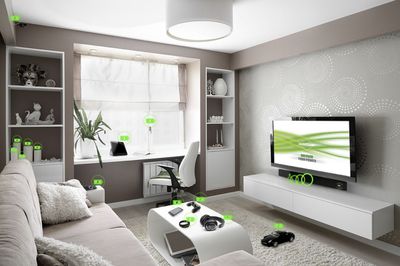Nearly three years after Energous debuted its wire-free "power-at-a-distance" charging system called WattUp, the Federal Communications Commission has now approved the technology. Specifically, the FCC certification is for the company's first-generation WattUp Mid Field transmitter, which powers up devices at a distance of up to three feet away (via Engadget).
The news marks the first FCC certification ever for a wire-free charging system, which Energous said will open up "a tremendous opportunity for the electronics industry." The company mentioned that the WattUp Mid Field transmitter could be used in the future by "nearly any small electronic device," including smartphones, tablets, smart watches, earbuds, wireless keyboards and mice, smart speakers, and more.

Next, Energous will demonstrate the WattUp technology at CES 2018 in January. CEO Stephen R. Rizzone mentioned that the system's ability to charge both wire-free and via a traditional mat system will give WattUp an edge on the market.
"Older wireless charging technologies have received limited adoption over the past 15 years, and are confined to contact-based charging only. The FCC certification of Energous' power-at-a-distance wireless charging transmitter is a major market milestone. It opens up options, outside of just contact-based charging, to Wireless Charging 2.0: an ecosystem where devices can be charged both, via pad and at a distance," said Stephen R. Rizzone, president and CEO of Energous.
"Untethered, wire-free charging -- such as charging a fitness band even while wearing it -- is exactly what consumers have been waiting for. We are now in a position to move our consumer electronics, IoT and smart home customers forward at an accelerated pace."
WattUp is able to charge any battery-operated device using a technique that Energous likens to Wi-Fi, as long as the device has one of the company's receivers. A WattUp Power Router (a "transmitter") emits energy using a radio frequency signal delivered by miniature antenna arrays and custom control chips. Devices with a WattUp "receiver" (consisting of multiple miniature antennas) are then able to convert that RF signal into battery power.
Following the debut of WattUp at CES 2015, speculation pointed towards Apple possibly working with Energous on implementing the receiver technology directly into future iPhones, or at least helping the company build a MFi certified WattUp iPhone accessory. Once rumors of wireless charging in the 2017 iPhone lineup began swirling, Apple and Energous were again tied together, but eventually Apple opted for inductive wireless charging on the iPhone 8 and iPhone X.
Energous doesn't have any consumer-available products for purchase yet, but it's expected that the company will announce more news about its WattUp device at CES, which runs January 9 through 12 in Las Vegas.
























Top Rated Comments
1. Dialog has already announced that Apple is going to drop them, and they're the exclusive suppliers for Energous chips. Although perhaps Apple could license to make their own for their own use. Unclear.
2. This is only for a trickle charge within 35" in a small cone from the transmitter. And any movement inside 20" turns it off.
Here's the FCC explanation of the device:
Here's a photo of the antenna and its inner exclusion zone. Any movement... even breathing... inside of 20" (50cm) and it shuts off for about 30 secs to keep from transmitting into human flesh over SAR limits.
I am not an antenna engineer, but the filing seems to indicate that the 12 antennas in the transmitter combined send about 10 watts (*). No idea how much total power is available at a nominal 60cm (24") distance, but since by that point it meets SAR standards, it's gotta be a trickle. (For antenna types, the test results show 45-75 v/ms at inner to outer test pockets.)
Plus, according to the filing it works best if the phone is in landscape mode, and an inch or so off the table. So by the time you worry about:
* finding enough clear space on your desk to put it (!),
* the phone's correct placement,
* staying inside 3 feet almost directly in front, and yet
* not making any movements inside the 20" safety arc,
you might as well use a cable or inductive charging stand.
In short, this is just another Energous BS filing designed to keep naive investors around.
(*) Which is why this was filed under Part 18 for industrial / science / medical devices instead of the usual consumer Part 15 with its max 1 Watt output.
Could there be a way to line the walls and ceiling with many directional antennas and automatic detection of humans/pets, so that many low power beams meet at a device? Sure, expensive, but could be. But such a concept has nothing to do with the raw blunt instrument in this thread.
Yep, even cell towers only use 5-10 Watts for each cell, and they're hundreds or thousands of feet away from us. By the time the data signal reaches us, it's usually in the microwatt range. (*)
Yet to send usable amounts of power to convert to battery charging electricity, this Energous device also has to transmit 10 watts or more, but it's within only a few feet from us! And thus it has to shut off entirely if it detects motion within 20", where the exposure amount would exceed FCC limits.
(*) Which is why it's such idiocy when well meaning but ignorant people say they want fewer cell towers. Fewer towers means cells have to transmit at a higher power, and moreover, so do the phones that we have next to our heads! Our phone's nearby power is many magnitudes higher than what we get back from the tower. Conversely, more towers = less transmitted power needed on both sides.
If it's not clear, I think Energous is butt.